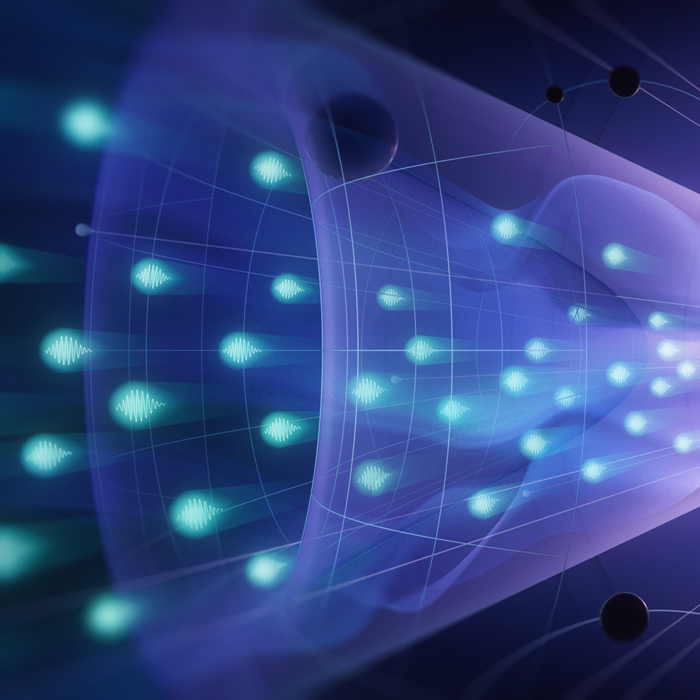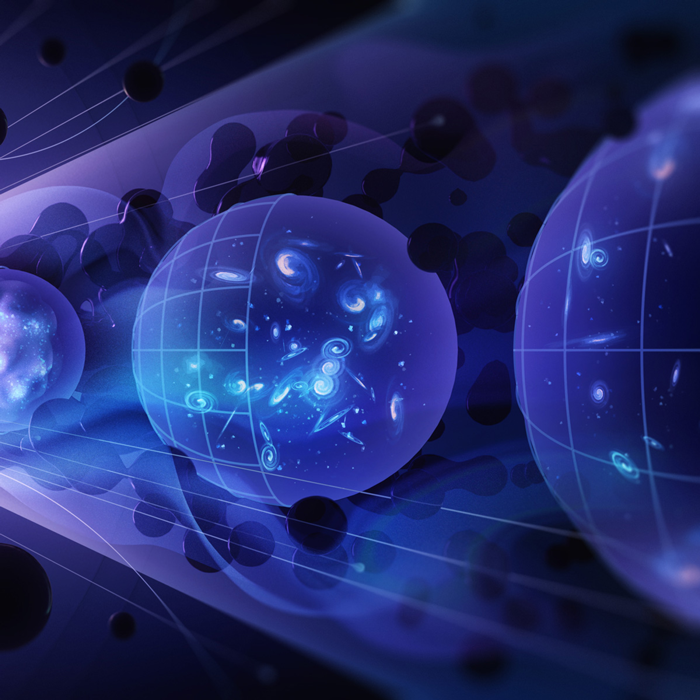Executive Summary
Executive Summary
Particle physics studies the smallest constituents of our vast and complex universe. At such small scales, the fundamental principles of quantum physics prevail. Remarkably, the entire observable universe, now billions of light years across, was once small enough to be quantum in nature. Its quantum history is imprinted on its large-scale structure.
Past successes in particle physics have revolutionized our understanding of the universe and prompted a new set of questions. Collectively, these questions have spurred the construction of state-of-the-art facilities, from particle accelerators to telescopes, that will illuminate the profound connections between the very small and the very large. We stand on the threshold of a new era of insight and discovery.
The 2023 Particle Physics Project Prioritization Panel (P5) was charged with developing a 10-year strategic plan for US particle physics, in the context of a 20-year global strategy and two constrained budget scenarios. An essential source of input was the 2021 Snowmass Community Planning Exercise organized by the Division of Particles and Fields of the American Physical Society. The panel received additional input from several other sources, including town hall meetings, laboratory visits, and individual communications. We found this input aligned with three overarching science themes. Within each theme we identified two focus areas, or science drivers, that represent the most promising avenues of investigation for the next 10 to 20 years.

Decipher
the
Quantum
Realm
Elucidate the Mysteries
of Neutrinos
Reveal the Secrets of
the Higgs Boson

Explore
New
Paradigms
in Physics
Search for Direct Evidence
of New Particles
Pursue Quantum Imprints
of New Phenomena

Illuminate
the
Hidden
Universe
Determine the Nature
of Dark Matter
Understand What Drives
Cosmic Evolution
The community presented P5 with more inspiring and ambitious projects than either budget scenario could accommodate. To guide the necessary choices, the panel categorized projects as small, medium, and large, based on their construction costs to the particle physics program. In the large and medium categories, initiatives were first prioritized based on individual scientific merit, then design maturity. An expert subcommittee independently reviewed the costs, technical risks, and schedule of large projects. The final prioritization holistically considered the cost of construction, commissioning, operations, and related research support, distributed over a 10- to 20-year period.
This report outlines an ambitious program balanced across science drivers. A mix of large-, medium-, and small-scale experiments ensures a continuous stream of groundbreaking research with exceptional discovery potential. The time-sequenced plan is summarized in Figure 1. We recommend continuing specific projects, strategically advancing some to the construction phase, and delaying others. Where necessary, individual phases or elements of a large-scale project are prioritized separately.
A significant consideration in the prioritization process was the execution of projects begun in the past decade. In addition to operating facilities producing excellent science, three major facilities are currently under construction: the High-Luminosity Large Hadron Collider (HL-LHC), the Deep Underground Neutrino Experiment (DUNE), and the Vera C. Rubin Observatory (Rubin). Each plays a crucial role in a different facet of the particle physics program. Our partnership in the HL-LHC at CERN will begin to unlock the secrets of the Higgs boson. DUNE is the centerpiece of a decades-long program to reveal the mysteries of elusive neutrinos. This US-hosted international project will exploit a unique underground laboratory (now nearing completion) and neutrino beams produced at Fermi National Accelerator Laboratory (Fermilab). The Rubin Observatory Legacy Survey of Space and Time (LSST) anchors an ongoing program of cosmic surveys. Realizing the full scientific potential of these and other ongoing projects is our highest priority.
The panel identified several crucial areas in cosmic evolution, neutrinos, and dark matter, where next-generation facilities with dramatically enhanced capabilities could have revolutionary impact.
The Cosmic Microwave Background Stage IV experiment (CMB-S4) will use telescopes sited in Chile and Antarctica to study the oldest light from the beginning of the universe. Achieving its goals requires unique US infrastructure at the South Pole.
Early implementation of a planned accelerator upgrade (Main Injector Ramp and Target; ACE-MIRT) at Fermilab advances the timeline of the DUNE program. The re-envisioned second phase of DUNE, which adds a third underground detector module and an upgraded near detector complex, further expands DUNE’s power and scope as a neutrino laboratory. We recommend research and development (R&D) toward an advanced fourth detector that could ultimately expand DUNE’s physics program.
A comprehensive program that includes a Generation 3 (G3) Dark Matter experiment will probe the enigmatic nature of dark matter, which makes up a significant portion of the universe’s mass and energy and has been one of the most enduring mysteries in modern physics. The recommended program also invests in multi-messenger observatories with dark matter sensitivity, including IceCube Gen-2, and small-scale dark matter experiments using innovative technologies.
In the area of colliders, the panel endorses an offshore Higgs factory, located in either Europe, including CERN, or Japan, to advance studies of the Higgs boson following the HL-LHC while maintaining a healthy onshore particle physics program. The US should actively engage in design studies to establish the technical feasibility and cost envelope of Higgs factory designs. We recommend that a targeted collider panel review the options after feasibility studies converge. At that point, it is recommended that the US commit funds commensurate with its involvement in the LHC and HL-LHC.
In addition to these major initiatives, the panel recommends support for a series of current and future mid-scale projects related to cosmic evolution, neutrinos, dark matter, and quantum imprints of new phenomena.
Small- and mid-scale projects play an essential role, complementing major facilities and ensuring the scientific balance of the proposed US program. Notably, small projects can rapidly seize on new opportunities as they arise. To preserve this agility, the panel recommends that the Department of Energy (DOE) create a new, competitive program named Advancing Science and Technology through Agile Experiments (ASTAE) to support a portfolio of small-scale and agile experiments. This program complements the successful Mid-Scale Research Infrastructure (MSRI) and Major Research Instrumentation (MRI) programs at the National Science Foundation (NSF). We recommend continued support for these vital components of the NSF research portfolio.
The panel recommends dedicated R&D to explore a suite of promising future projects. One of the most ambitious is a future collider concept: a 10 TeV parton center-of-momentum (pCM) collider to search for direct evidence and quantum imprints of new physics at unprecedented energies. Turning this concept into a cost-effective, realistic collider design demands that we aggressively develop multiple innovative accelerator and detector technologies. This process will establish whether a proton, electron, or muon accelerator is the optimal path to our goal.
As part of this initiative, we recommend targeted collider R&D to establish the feasibility of a 10 TeV pCM muon collider. A key milestone on this path is to design a muon collider demonstrator facility. If favorably reviewed by the collider panel, such a facility would open the door to building facilities at Fermilab that test muon collider design elements while producing exceptionally bright muon and neutrino beams. By taking up this challenge, the US blazes a trail toward a new future by advancing critical R&D that can benefit multiple science drivers and ultimately bring an unparalleled global facility to US soil.
Investing in the scientific workforce and enhancing computational and technological infrastructure is crucial. To achieve this goal, funding agencies should support programs that foster a supportive, collaborative work environment; help recruit and retain diverse talent; and reinforce professional standards. Targeted increases in support for theory, general accelerator R&D (GARD), instrumentation, and computing will bolster areas where US leadership has begun to erode. These areas align with national initiatives in artificial intelligence and machine learning (AI/ML), quantum information science (QIS), and microelectronics, creating valuable synergies. Such increased support maximizes the return on scientific investments, fosters innovation, and benefits society in domains from medicine to national security.
The impact of the more constrained budget scenario is severe. It forces the US to cede leadership in many initiatives to other regions of the world and reduces investments in workforce and future technologies to critical levels. Specifically, the G3 dark matter exploration would be relocated outside the US, and elements of DUNE would be descoped or delayed. This limiting of DUNE’s physics reach would negatively impact the reputation of the US as an international host, and more limited contributions to an offshore Higgs factory would tarnish our standing as a partner for future global facilities. Conversely, a modest increase in budget over the less constrained scenario allows for additional pathways to discovery by accelerating science, leveraging existing investments, and solidifying US scientific leadership in the international context.
We have crafted a well-balanced program that is technically and financially feasible for the coming 10 years and builds toward a longer-term vision of US leadership and scientific discovery in particle physics. As this program is realized, we look forward to sharing new insights into the quantum universe.
